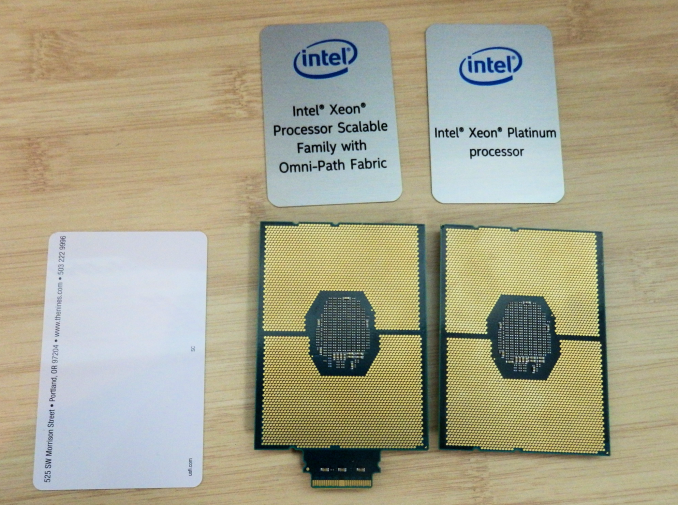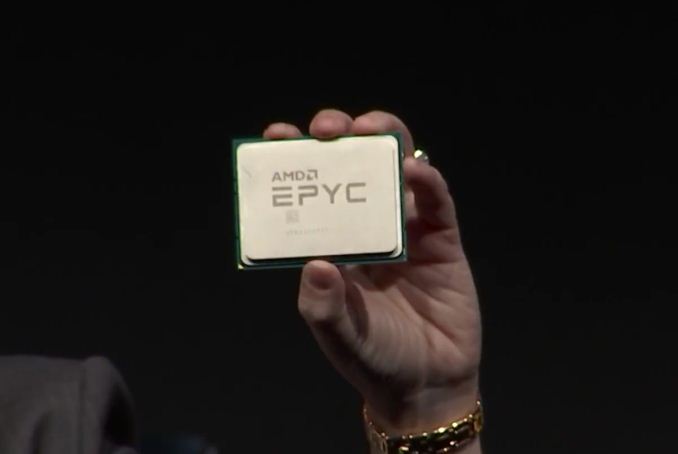Sizing Up Servers: Intel's Skylake-SP Xeon versus AMD's EPYC 7000 - The Server CPU Battle of the Decade?
by Johan De Gelas & Ian Cutress on July 11, 2017 12:15 PM EST- Posted in
- CPUs
- AMD
- Intel
- Xeon
- Enterprise
- Skylake
- Zen
- Naples
- Skylake-SP
- EPYC

This morning kicks off a very interesting time in the world of server-grade CPUs. Officially launching today is Intel's latest generation of Xeon processors, based on the "Skylake-SP" architecture. The heart of Intel's new Xeon Scalable Processor family, the "Purley" 100-series processors incorporate all of Intel's latest CPU and network fabric technology, not to mention a very large number of cores.
Meanwhile, a couple of weeks back AMD soft-launched their new EPYC 7000 series processors. Based on the company's Zen architecture and scaled up to server-grade I/O and core counts, EPYC represents an epic achievement for AMD, once again putting them into the running for competitive, high performance server CPUs after nearly half a decade gone. EPYC processors have begun shipping, and just in time for today's Xeon launch, we also have EPYC hardware in the lab to test.
Today's launch is a situation that neither company has been in for quite a while. Intel hasn't had serious competition in years, and AMD has't been able to compete. As a result, both companies are taking the other's actions very seriously.
In fact we could go on for much longer than our quip above in describing the rising tension at the headquarters of AMD and Intel. For the first time in 6 years (!), a credible alternative is available for the newly launched Xeon. Indeed, the new Xeon "Skylake-SP" is launching today, and the yardstick for it is not the previous Xeon (E5 version 4), but rather AMD's spanking new EPYC server CPU. Both CPUs are without a doubt very different: micro architecture, ISA extentions, memory subsystem, node topology... you name it. The end result is that once again we have the thrilling task of finding out how the processors compare and which applications their various trade-offs make sense.
The only similarity is that both server packages are huge. Above you see the two new Xeon packages –with and without an Omni-Path connector – both of which are as big as a keycard. And below you can see how one EPYC CPU fills the hand of AMD's CEO Dr. Lisa Su.
Both are 64 bit x86 CPUs, but that is where the similarities end. For those of you who have been reading Ian's articles closely, this is no surprise. The consumer-focused Skylake-X is the little brother of the newly launched Xeon "Purley", both of which are cut from the same cloth that is the Skylake-SP family. In a nutshell, the Skylake-SP family introduces the following new features:
- AVX-512 (Many different variants of the ISA extension are available)
- A 1 MB (instead of a 256 KB) L2-cache with a non-inclusive L3
- A mesh topology to connected the cores and L3-cache chunks together
Meanwhile AMD's latest EPYC Server CPU was launched a few weeks ago:
On the package are four silicon dies, each one containing the same 8-core silicon we saw in the AMD Ryzen processors. Each silicon die has two core complexes, each of four cores, and supports two memory channels, giving a total maximum of 32 cores and 8 memory channels on an EPYC processor. The dies are connected by AMD’s newest interconnect, the Infinity Fabric...
In the next pages, we will be discussing the impact of these architectural choices on server software.











219 Comments
View All Comments
Shankar1962 - Thursday, July 13, 2017 - link
So you think Intel won't release anything new again by then? Intel would be ready for cascadelake by then. None of the big players won't switch to AMD. Skylake alone is enough to beat epyc handsomely and cascadelake will just blow epyc. Its funny people are looking at lab results when real workloads are showing 1.5-1.7x speed improvementPixyMisa - Saturday, July 15, 2017 - link
This IS comparing AMD to Intel's newest CPUs, you idiot. Skylake loses to Epyc outright on many workloads, and is destroyed by Epyc on TCO.Shankar1962 - Sunday, July 16, 2017 - link
Mind your language assholeEither continue the debate or find another place for your shit and ur language
Real workloads don't happen in the labs you moron
Real workloads are specific to each company and Intel is ahead either way
If you have the guts come out with Q3 Q4 2017 and 2018 revenues from AMD
If you come back debating epyc won over skylake if AMD gets 5-10% share then i pity your common sense and your analysis
You are a bigger idiot because you spoiled a healthy thread where people were taking sides by presenting technical perspective
PixyMisa - Tuesday, July 25, 2017 - link
I'm sorry you're an idiot.Shankar1962 - Thursday, July 13, 2017 - link
Does not matter. We can debate this forever but Intel is just ahead and better optimized for real world workloads. Nvidia i agree is a potential threat and ahead in AI workloads which is the future but AMD is just an unnecessary hype. Since the fan boys are so excited with lab results (funny) lets look at Q3,Q4 results to see how many are ordering to test it for future deployment.martinpw - Wednesday, July 12, 2017 - link
I'm curious about the clock speed reduction with AVX-512. If code makes use of these instructions and gets a speedup, will all other code slow down due to lower overall clock speeds? In other words, how much AVX-512 do you have to use before things start clocking down? It feels like it might be a risk that AVX-512 may actually be counterproductive if not used heavily.msroadkill612 - Wednesday, July 12, 2017 - link
(sorry if a repost)Well yeah, but this is where it starts getting weird - 4-6 vega gpuS, hbm2 ram & huge raid nvme , all on the second socket of your 32 core, c/gpu compute ~Epyc server:
https://marketrealist.imgix.net/uploads/2017/07/A1...
from
http://marketrealist.com/2017/07/how-amd-plans-to-...
All these fabric linked processors, can interact independently of the system bus. Most data seems to get point to point in 2 hops, at about 40GBps bi-directional (~40 pcie3 lanes, which would need many hops), and can be combined to 160GBps - as i recall.
Suitably custom hot rodded for fabric rather than pcie3, the nvme quad arrays could reach 16MBps sequential imo on epycs/vegaS native nvme ports.
To the extent that gpuS are increasing their role in big servers, intel and nvidea simply have no answer to amd in the bulk of this market segment.
davide445 - Wednesday, July 12, 2017 - link
Finally real competition in the HPC market. Waiting for the next top500 AMD powered supercomputer.Shankar1962 - Wednesday, July 12, 2017 - link
Intel makes $60billion a year and its official that Skylake was shipping from Feb17 so i do not understand this excitement from AMD fan boys......if it is so good can we discuss the quarterly revenues between these companies? Why is AMD selling for very low prices when you claim superior performance over Intel? You can charge less but almost 40-50% cheap compared to Intel really?AMD exists because they are always inferior and can beat Intel only by selling for low prices and that too for what gaining 5-10% market which is just a matter of time before Intel releases more SKUs to grab it back
What about the software optimizations and extra BOM if someone switches to AMD?
What if AMD goes into hibernation like they did in last 5-6years?
Can you mention one innovation from AMD that changed the world?
Intel is a leader and all the technology we enjoy today happenned because of Intel technology.
Intel is a data center giant have head start have the resources money acquisitions like altera mobileeye movidus infineon nirvana etc and its just impossible that they will lose
Even if all the competent combines Intel will maintain atleast 80% share even 10years from now
Shankar1962 - Wednesday, July 12, 2017 - link
To add onNo one cares about these lab tests. Let's talk about the real world work loads.
Look at what Google AWS ATT etc has to say as they already switched to xeon sky lake
We should not really be debating if we have the clarity that we are talking about AMD getting just 5% -10% share by selling high end products they have for cheap prices....they fo not make too much money by doing that.....they have no other option as thats the only way they can dream of a 5-10% market share
For Analogy think Intel in semiconductor as Apple in selling smartphones
Intel has gross margins of ~63%
They have a solid product portfolio technologies and roadmap .....we can debate this forever but the revenues profits innovations and history between these companies can answer everything